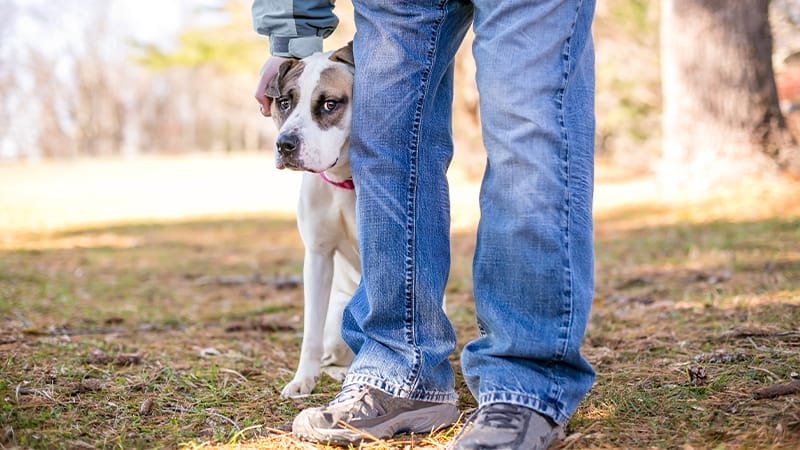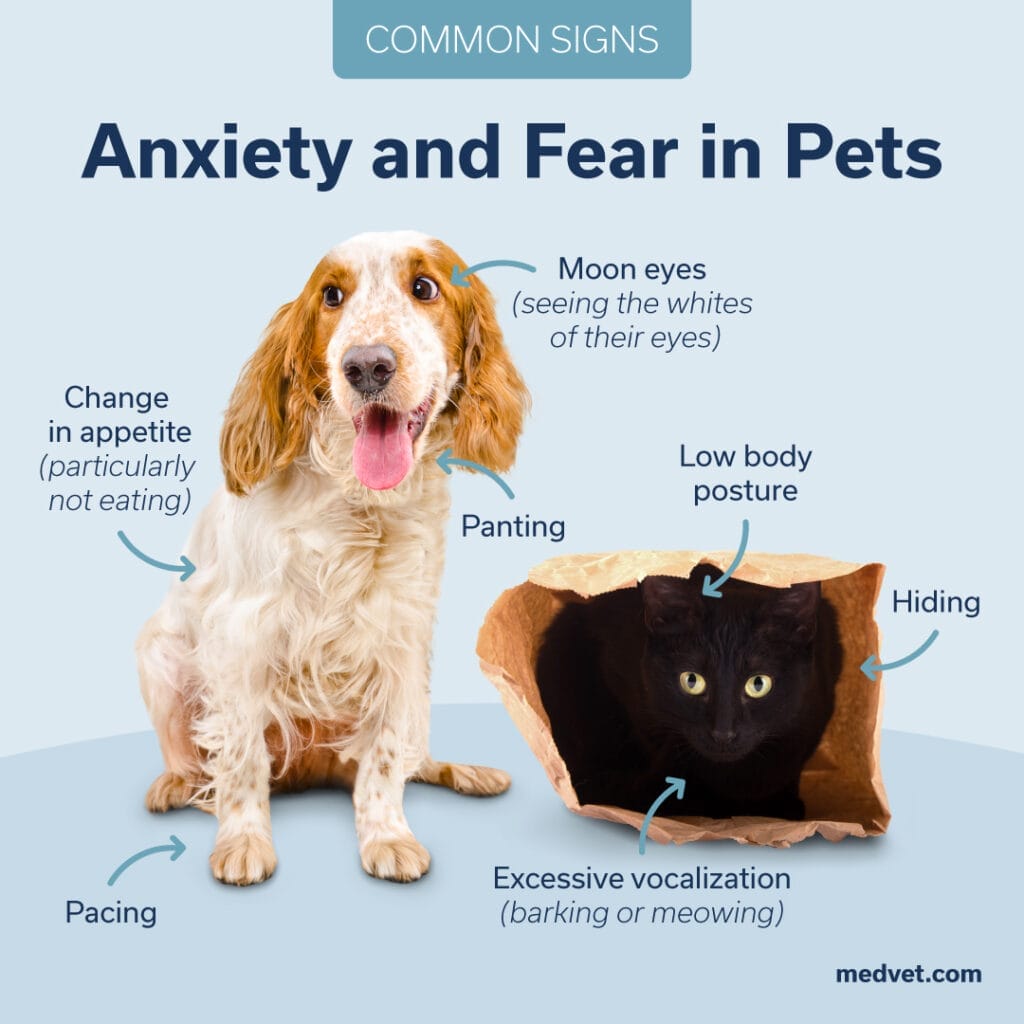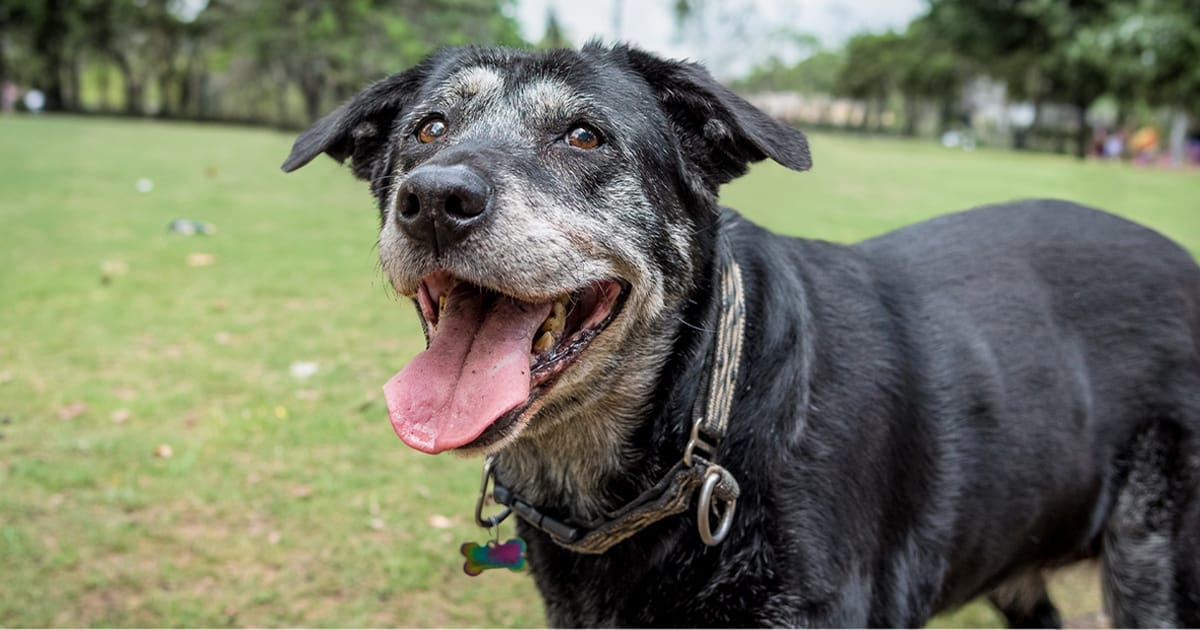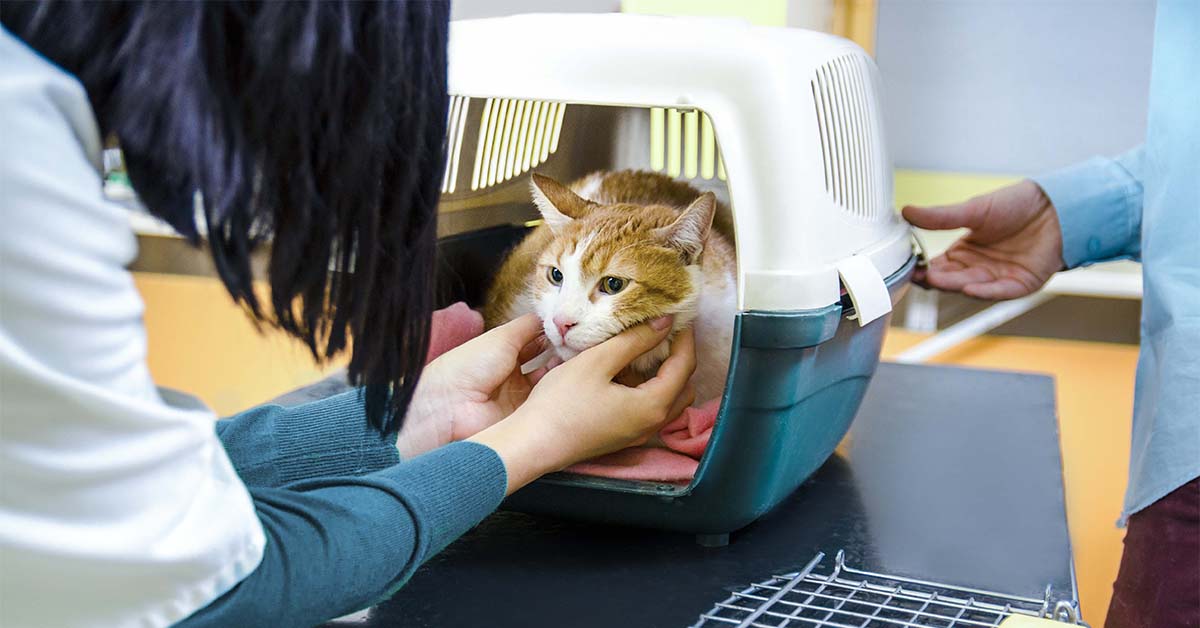Five Common Pet Fears: What You Can Do to Help Your Pet
Pets can experience fear, anxiety, or phobias just like humans. Learn how to help your pet cope with these feelings and behavior.
Just like humans, pets can experience fear, anxiety, or even phobias. Here, we will discuss five common pet fears, signs your pet may be anxious, how to help your pet be less afraid, and when to visit your family veterinarian. By understanding your pet’s fears and providing the right support, you can help them live a happier, healthier life.
Five Common Pet Fears
While pets can be fearful of many things, there are some common things that scare pets, including:
- Loud Noises – Thunderstorms, fireworks, vacuum cleaners, and even blenders, are noises some pets are sensitive to that may cause them to react negatively. Pets can find loud noises bothersome because their hearing is more sensitive to changes in volume and pitch than ours. Additionally, when they can’t determine the source of sounds like thunder or fireworks, it can be even scarier for them.
- Grooming – Pets may not enjoy grooming because of the sounds, like the noise of a nail grinder or the air from a hair dryer, the sensations they experience during the process, and being in strange place. Additionally, some pets, particularly cats, may not enjoy baths due to their aversion to water.
- Separation or Being Alone – Some pets, particularly dogs, can become overly attached to their owners and experience distress when separated from them.
- Strangers or Other Animals – Pets can be afraid of other animals or people because of their perceived lack of safety. They may also avoid certain people if they have had a negative interaction with them in the past.
- Veterinary Visits – If you’ve ever placed a cat in a carrier for a car ride to the veterinarian, you’ve likely experienced how fearful they may be of the adventure. That fear can carry into their behavior when a veterinarian examines them as well. Some veterinarians, including MedVet, practice fear-free techniques to calm pets.

Signs Your Pet May Be Anxious or Fearful
The signs our pets exhibit can vary widely when they are stressed or fearful. More common signs in cats and dogs are:
- Excessive vocalization (barking or meowing)
- Hiding
- Low body posture
- Panting
- Pacing
- Salivating
- Tremoring or shivering
- Moon eyes (seeing the whites of their eyes)
- Change in appetite, particularly not eating

Helping Your Pet Manage Their Anxiety
Although the best approach for helping your pet manage their fears is dependent upon what is causing their anxiety, there are some general techniques that comfort most pets.
One of the most important things you can do is remove your pet from the stimuli and create a safe environment for them to retreat to when they are feeling anxious. Placing a pet bed in an area that is somewhat enclosed with minimal noise disturbances can help them feel more secure. The environment will feel even more cozy to them if it contains some of their favorite toys, a beloved blanket, or an item that brings them comfort.
Creating a “safe space” for your pet is important, but you can also use positive reinforcement techniques to help reduce their fear response to stressful situations. By speaking to your pet in a calm voice, praising them, or offering treats, you can motivate them to overcome their fears while reinforcing good behavior. Remember, pets can sense your emotions, so staying calm is crucial. Making a big fuss or raising your voice can make them more anxious and increase the likelihood of them getting upset.
It is important to introduce your pet to new situations gradually rather than overwhelming your pet all at once. This practice is called desensitization. For example, if your pet fears strangers, have them meet a single person from far away before allowing them closer contact over time. This helps create positive associations with the situation while avoiding any sudden triggers of fear or anxiety.
Consistency is also important in promoting comfort to your pet. A regular daily routine that includes exercise, mental stimulation, and playtime is beneficial in keeping your pet relaxed and confident. In situations where your pet may experience anxiety, it is advisable to limit contact with strangers or children to prevent any potential biting or scratching incidents that may arise from their fear.
When to Seek Veterinary Guidance for Pet Fears
If your pet is not finding comfort with a place to retreat, desensitization to what causes them fear, praise and rewards, and a regular routine, we suggest consulting with your family veterinarian. They can assess your pet to determine if there is an underlying medical issue contributing to your pet’s situation. They can also determine if supplements, medications, environmental changes, or animal-assisted therapy, may be beneficial for severe cases of phobia or trauma.
If your pet stops eating, experiences shortness of breath, increased heart rate, or other physical signs (such as aggression) due to being scared or anxious, it is important to reach out to your family veterinarian immediately. If your family veterinarian is unavailable, you can visit your nearest MedVet.
Managing Anxiety Around Veterinary Visits
While your veterinarian is an excellent resource for addressing your pet’s fears, a visit to their office can also be a source of stress. At MedVet, some of our team members are fear-free certified and balance the pet’s (and owner’s) emotional and physical wellbeing to make visits more pleasant.
Planning a stress-free vet visit begins before you even reach our doors, like bringing your pet, particularly cats, to our hospitals in a carrier that smells familiar to them. It’s also important to bring your pet in hungry so they’re food motivated. While we aim to minimize how long a pet is in our waiting area, some facilities have designated separate areas for cats and dogs.
During their time with your pet, our fear-free practitioners use techniques to make your pet feel comfortable and less anxious. This can include things like offering pets treats, toys, or petting/brushing during exams. Approaching animals in a slow manner and speaking in quiet voices is also important as dogs and cats are sensitive to loud noises and quick movements. If a pet needs to be restrained for a procedure, such as obtaining a blood sample or performing diagnostic testing, team members may use a towel wrap, muzzle, Elizabethan collar, or mild sedative to ensure the pet is comfortable.

Your Pet’s Wellbeing
Fear and anxiety can have a significant impact on the wellbeing of our furry friends. Being aware of the physical and behavioral signs, ways to help your pet cope with these feelings, and knowing when to seek veterinary care, can help you manage your pet’s fears and help them lead healthy lives.
To learn more about pet fears and ways to ensure your pet lives a happier, healthier life, we encourage you to visit MedVet’s Pet Care Resources library.
FAQs
Learn More
For ways to ensure your pet lives a happier, healthier life, visit our Pet Care Resources library.
Pet Care ResourcesContents
Learn More
For ways to ensure your pet lives a happier, healthier life, visit our Pet Care Resources library.
Pet Care Resources


